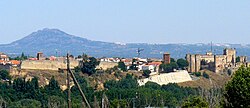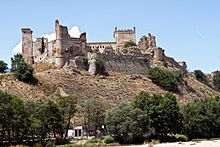Escalona
Escalona | |
|---|---|
| Escalona del Alberche | |
 | |
| Coordinates: 40°10′15″N 4°24′19″W / 40.17083°N 4.40528°W | |
| Country | Spain |
| Autonomous community | Castilla-La Mancha |
| Province | Toledo |
| Comarca | Torrijos |
| Judicial district | Torrijos |
| Founded | Ver texto |
| Government | |
| • Alcalde | Álvaro Gutiérrez Prieto (2007) |
| Area | |
| • Total | 73 km2 (28 sq mi) |
| Elevation | 550 m (1,800 ft) |
| Population (2018)[1] | |
| • Total | 3,199 |
| • Density | 44/km2 (110/sq mi) |
| Demonym | Escaloneros |
| Time zone | UTC+1 (CET) |
| • Summer (DST) | UTC+2 (CEST) |
| Postal code | 45910 |
| Dialing code | 925 |
| Website | Official website |
Escalona is a municipality located in the north of the province of Toledo, which in turn is part of the autonomous community of Castile-La Mancha, Spain. According to the 2017 census (INE), the municipality has a population of 3,240 inhabitants, many of whom are settled in several housing estates outside the town itself.
The town lies 30 metres above the right bank of the river Alberche, in the comarca of Torrijos, which is a part of the historical region of New Castile.
History
[edit]
Escalona's strategic location, on the Alberche river and between Avila and Toledo, suggests there may have been a fortress there in Roman times or during the Visigoth period. Following the conquest of Toledo (1085), by Alfonso VI of León and Castile, it was a key defensive point against raids by the Almoravides and Almohades that attacked the place in 1131, 1137 and, again, in 1196.[2]
The Mudéjar-style Castle of Escalona, built in the 15th century,[2] is the most characteristic building of the town.
Historically, there was a Jewish community in Esacalona, dating to before the Christian conquest in 1083, but remained in the town after it. The rights of the Jews in Escalona were established by the town's municipal charter, granting them equal status with Christians and Moors. A Jewish quarter existed from 1477 to 1489; in 1483, the Muslim mosque was included in the Jewish quarter. Isaac Abarbanel had business interests in Escalona. The community continued to exist until the 1492 expulsion of the Jews.[3]
Demographics
[edit]| Year | Pop. | ±% |
|---|---|---|
| 1900 | 1,272 | — |
| 1910 | 1,553 | +22.1% |
| 1920 | 1,634 | +5.2% |
| 1930 | 1,758 | +7.6% |
| 1940 | 1,821 | +3.6% |
| 1950 | 1,806 | −0.8% |
| 1960 | 1,643 | −9.0% |
| 1970 | 1,429 | −13.0% |
| 1981 | 1,537 | +7.6% |
| 1991 | 1,763 | +14.7% |
| 2001 | 2,193 | +24.4% |
| 2011 | 3,540 | +61.4% |
| 2021 | 3,441 | −2.8% |
| 2023 | 3,669 | +6.6% |
| Source: INE[4][5] | ||
Twin towns
[edit]- Villena, Spain
- Peñafiel, Spain
Notable people
[edit]- Juan Manuel (1282–1348), writer
- Esteban de Aguilar y Zúñiga, theologian
References
[edit]- ^ Municipal Register of Spain 2018. National Statistics Institute.
- ^ a b (in Spanish) Sureda Pons, Joan, ed. (1998). España Gótica: Castilla-La Mancha, pp. 142-5. Ediciones Encuentro. ISBN 8474905095. Google Books. Retrieved 15 March 2023.
- ^ "Escalona". Jewish Virtual Library. Retrieved 28 June 2024.
- ^ "Toledo(3078)". INE (in Spanish). Retrieved 2024-02-19.
- ^ "Toledo: Población por municipios y sexo. (2902)". INE (in Spanish). Retrieved 2024-02-19.
External links
[edit]- Instituto Nacional de Estadística (INE) website
- Official website of the Diputación Provincial de Toledo



